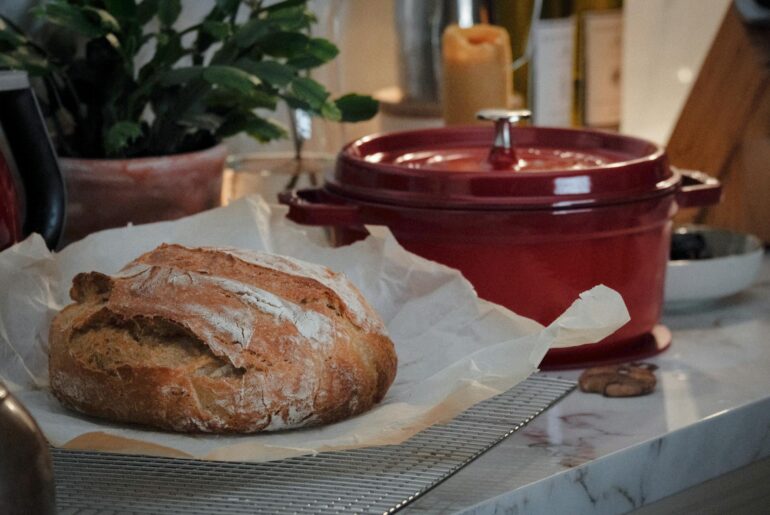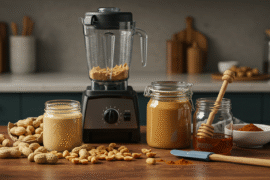This article may contain references to products or services from one or more of our advertisers or partners. We may receive compensation when you click on links to those products or services. Nonetheless, our opinions are our own.
The information presented in this article is accurate to the best of our knowledge at the time of publication. However, information is subject to change, and no guarantees are made about the continued accuracy or completeness of this content after its publication date.
- How to Clean a Dutch Oven and Keep It Looking Like New
- Know Your Dutch Oven: Materials Matter
- Cleaning Techniques for Everyday Use and Deep Stains
- Natural and Eco-Friendly Cleaning Alternatives
- Preventive Care: Protecting Against Future Stains
- Routine Maintenance for Lasting Performance
- When to Consider Professional Restoration
- Common Questions About Dutch Oven Care
- Recommended Reads
How to Clean a Dutch Oven and Keep It Looking Like New
Dutch ovens are renowned for their durability and versatility. From baking artisan bread to slow-simmered stews, they are often a centerpiece of thoughtful home cooking. However, their longevity depends greatly on proper maintenance. Stains, discoloration, and residue can accumulate over time, dulling their beauty and potentially affecting performance.
Know Your Dutch Oven: Materials Matter
Dutch ovens are typically made from either enamel-coated cast iron or raw cast iron, each requiring distinct care methods.
- Enamel-Coated Cast Iron: Durable but sensitive to thermal shock, scratches, and staining. Avoid abrasive cleaning tools to preserve the glossy surface.
- Raw Cast Iron: Prone to rust if not seasoned and dried properly. Builds a natural non-stick patina over time through repeated seasoning.
Understanding the construction of your Dutch oven is essential to applying the most effective and safe cleaning techniques.
Cleaning Techniques for Everyday Use and Deep Stains
Routine cleaning is straightforward and should be performed after each use:
- Allow the pot to cool completely before cleaning.
- Use warm water, a mild dish soap, and a soft sponge to wipe away residue.
- Avoid steel wool or other abrasive pads, which can damage the enamel or remove seasoning.
For stubborn stains or burnt-on food, a more intensive approach is needed:
- Baking Soda Paste: Combine baking soda with a small amount of water to form a paste. Apply it to the affected areas, let sit for 15–20 minutes, then scrub gently.
- Simmering Solution: Fill the pot with water, add one tablespoon of baking soda, and simmer for 5–10 minutes. Allow to cool, then clean as usual.
These methods effectively break down residue without harming the surface.
Voted "Best Overall Budgeting App" by Forbes and WSJ
Monarch Money helps you budget, track spending, set goals, and plan your financial future—all in one app.
Get 50% OFF your first year with code MONARCHVIP
Natural and Eco-Friendly Cleaning Alternatives
For those seeking a gentler approach with household staples, natural ingredients offer effective results:
- Baking Soda and Vinegar: Sprinkle baking soda over stained surfaces, then pour in white vinegar. Let the mixture bubble and settle. Scrub gently and rinse thoroughly.
- Lemon Juice: Adds freshness and helps reduce lingering food odors. A few drops wiped across the interior after cleaning can help refresh the surface.
These solutions are safe for enamel and provide excellent results without introducing harsh chemicals.
Preventive Care: Protecting Against Future Stains
Maintaining a Dutch oven goes beyond just cleaning. Preventative measures extend the life of the cookware and reduce the need for deep scrubbing:
- Avoid using extremely high heat unless required by a recipe. Excessive temperatures can cause enamel to discolor over time.
- Never place a hot Dutch oven under cold water. The sudden temperature change can cause cracks or weaken the enamel.
- Use wooden or silicone utensils to protect the cooking surface from scratches.
- Re-season raw cast iron regularly to prevent rust and maintain a natural non-stick layer.
These habits require little time to adopt but have a significant impact on preserving the integrity of your Dutch oven.
Routine Maintenance for Lasting Performance
Beyond daily cleaning, regular care habits are vital for ensuring longevity:
- Hand Wash Only: Dishwashers may be convenient, but the intense water pressure and heat can degrade enamel or strip seasoning.
- Thorough Drying: Always dry completely before storing. Lingering moisture encourages rust, particularly with raw cast iron.
- Ventilated Storage: Store with the lid slightly ajar to prevent moisture buildup and lingering odors.
These practices ensure your cookware remains in excellent condition for years.
When to Consider Professional Restoration
Despite the best efforts, some Dutch ovens may require restoration—especially those passed down through generations or neglected over time. Severe rust, deeply embedded stains, or damaged enamel may benefit from professional services. Specialty restoration shops can often rehabilitate even the most worn pieces safely and effectively.
Common Questions About Dutch Oven Care
What’s the safest method to clean without damaging the surface?
Use a soft sponge and mild dish soap after the oven cools. For tougher stains, opt for baking soda or a water-baking soda simmer. Always avoid abrasive pads or dishwashers.
How can stuck-on food be removed effectively?
Create a baking soda paste or simmer water with baking soda in the oven. Let the solution work for several minutes, then wipe away gently with a sponge.
Should metal utensils be avoided?
Yes. Metal can scratch enamel and damage the seasoned surface of raw cast iron. Use silicone, wood, or plastic tools instead.
How frequently should cast iron be seasoned?
Re-season every few uses or after deep cleaning. Seasoning helps maintain a rust-resistant, naturally non-stick surface.

Reviewed and edited by Albert Fang.
See a typo or want to suggest an edit/revision to the content? Use the contact us form to provide feedback.
At FangWallet, we value editorial integrity and open collaboration in curating quality content for readers to enjoy. Much appreciated for the assist.
Did you like our article and find it insightful? We encourage sharing the article link with family and friends to benefit as well - better yet, sharing on social media. Thank you for the support! 🍉
Article Title: The Best Ways to Clean Your Dutch Oven (and Prevent New Stains)
https://fangwallet.com/2025/04/19/clean-dutch-oven/The FangWallet Promise
FangWallet is an editorially independent resource - founded on breaking down challenging financial concepts for anyone to understand since 2014. While we adhere to editorial integrity, note that this post may contain references to products from our partners.
The FangWallet promise is always to have your best interest in mind and be transparent and honest about the financial picture.
Become an Insider

Subscribe to get a free daily budget planner printable to help get your money on track!
Make passive money the right way. No spam.
Editorial Disclaimer: The editorial content on this page is not provided by any of the companies mentioned. The opinions expressed here are the author's alone.
The content of this website is for informational purposes only and does not represent investment advice, or an offer or solicitation to buy or sell any security, investment, or product. Investors are encouraged to do their own due diligence, and, if necessary, consult professional advising before making any investment decisions. Investing involves a high degree of risk, and financial losses may occur including the potential loss of principal.
Source Citation References:
+ Inspo
There are no additional citations or references to note for this article at this time.












































